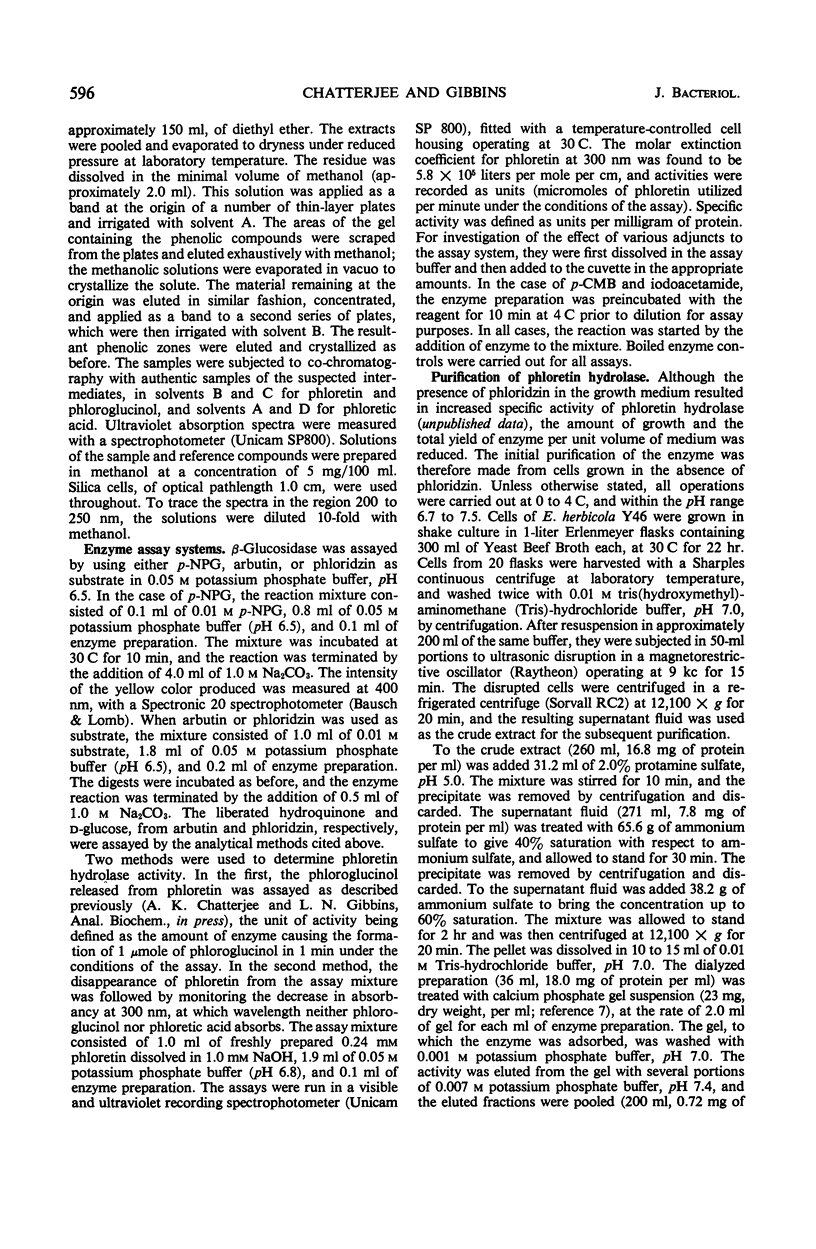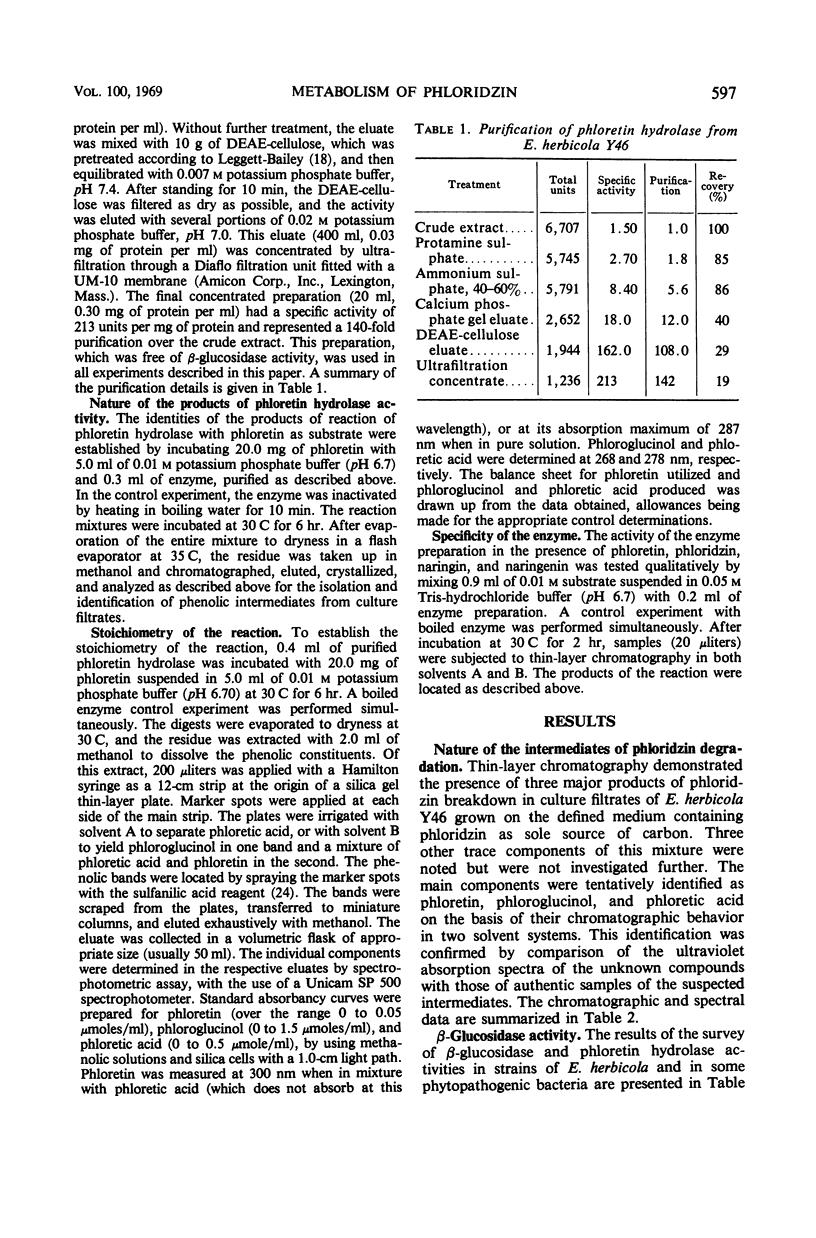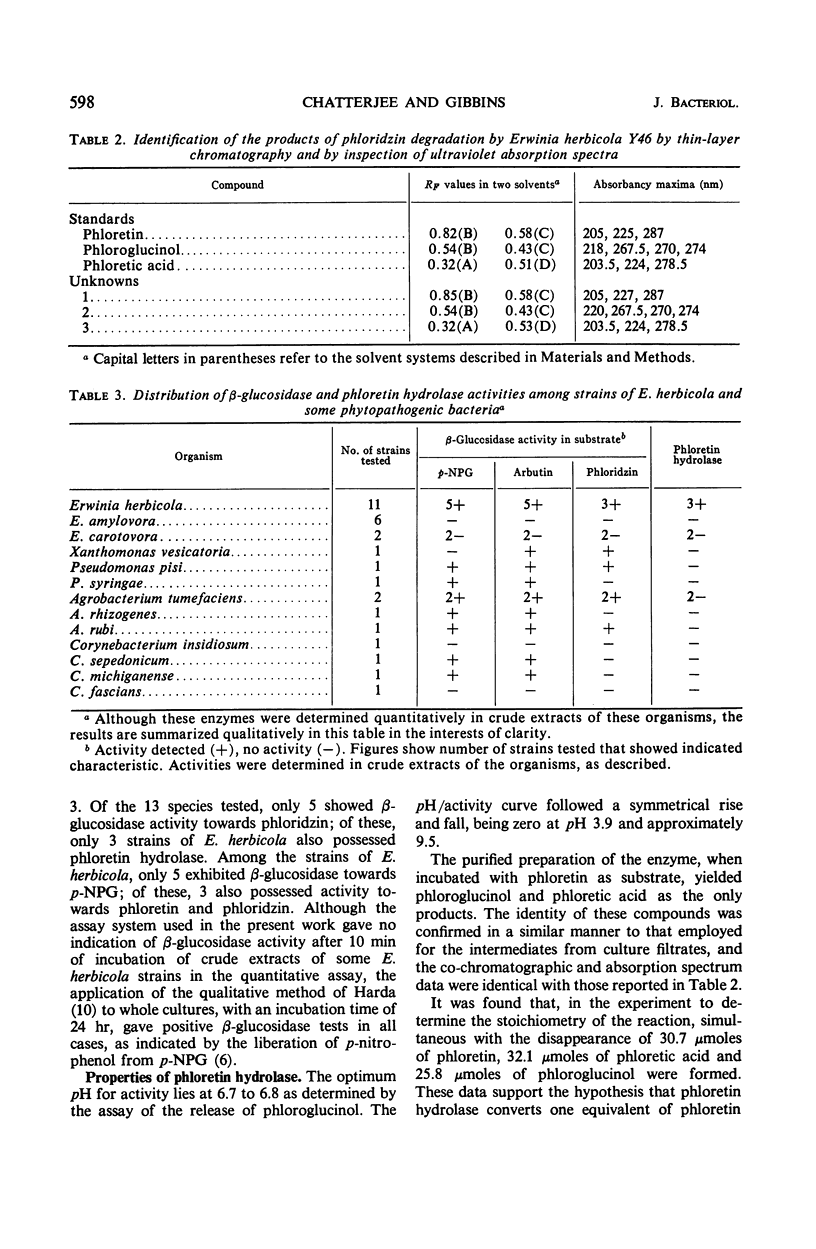Abstract
Erwinia herbicola Y46 degrades phloridzin to yield phloretin, phloroglucinol, and phloretic acid, when grown on defined medium containing phloridzin as the sole source of carbon. The identities of the intermediates isolated from culture filtrates were established by co-chromatography and by ultraviolet absorption spectra. Only 3 of 11 strains of this species, and none of the 12 species of bacterial phytopathogens tested could effect this breakdown. Some of the latter organisms possessed β-glucosidase activity which liberated d-glucose from phloridzin. The enzyme phloretin hydrolase was purified from cells of E. herbicola Y46 grown on Yeast Beef Broth, by treatment of crude extracts with protamine sulfate, ammonium sulfate precipitation, elution from calcium phosphate gel, elution from diethylaminoethyl-cellulose, and concentration by ultrafiltration. The final preparation was free of β-glucosidase, had a specific activity of 213 units per mg of protein, and represented a 142-fold purification over the crude extract. The enzyme had a pH optimum of 6.7 to 6.8, and produced only phloroglucinol and phloretic acid as products of phloretin breakdown, there being an equimolar relationship between the cleavage of phloretin and the formation of the products. The Michaelis constant (Km) for the enzyme with phloretin as substrate was 3.8 × 10−5m, and the enzyme was sensitive to Hg2+ and Cu2+ ions. Phloroglucinol, phloretic acid, p-chloromercuribenzoate and iodoacetamide were without effect on the activity. The enzyme did not react with phloridzin, naringin, or naringenin. The physiological significance of the results is discussed.
Full text
PDF






Selected References
These references are in PubMed. This may not be the complete list of references from this article.
- BARNES E. H., WILLIAMS E. B. The role of phloridzin in the host-parasite physiology of the apple scab disease. Can J Microbiol. 1961 Aug;7:525–534. doi: 10.1139/m61-062. [DOI] [PubMed] [Google Scholar]
- BARNETT J. A., INGRAM M., SWAIN T. The use of beta-glucosides in classifying yeasts. J Gen Microbiol. 1956 Dec;15(3):529–555. doi: 10.1099/00221287-15-3-529. [DOI] [PubMed] [Google Scholar]
- Benmaman J. D., Sorby D. L. Procedures for characterization of the degradation products of methyl and ethyl p-hydroxybenzoate by thin-layer chromatography. J Chromatogr. 1965 Dec;20(3):607–610. doi: 10.1016/s0021-9673(01)97471-0. [DOI] [PubMed] [Google Scholar]
- Chatterjee A. K., Gibbins L. N., Carpenter J. A. Some observations on the physiology of Erwinia herbicola and its possible implication as a factor antagonistic to Erwinia amylovora in the "fire-blight" syndrome. Can J Microbiol. 1969 Jun;15(6):640–642. [PubMed] [Google Scholar]
- Groves W. E., Davis F. C., Jr, Sells B. H. Spectrophotometric determination of microgram quantities of protein without nucleic acid interference. Anal Biochem. 1968 Feb;22(2):195–210. doi: 10.1016/0003-2697(68)90307-2. [DOI] [PubMed] [Google Scholar]
- Hendry A. T., Carpenter J. A., Garrard E. H. Bacteriophage studies of isolates from fire blight sources. Can J Microbiol. 1967 Oct;13(10):1357–1364. doi: 10.1139/m67-182. [DOI] [PubMed] [Google Scholar]
- Hildebrand D. C., Schroth M. N. beta-Glucosidase Activity in Phytopathogenic Bacteria. Appl Microbiol. 1964 Nov;12(6):487–491. doi: 10.1128/am.12.6.487-491.1964. [DOI] [PMC free article] [PubMed] [Google Scholar]
- LOWRY O. H., ROSEBROUGH N. J., FARR A. L., RANDALL R. J. Protein measurement with the Folin phenol reagent. J Biol Chem. 1951 Nov;193(1):265–275. [PubMed] [Google Scholar]
- Van Sumere C. F., Wolf G., Teuchy H., Kint J. A new thin-layer method for phenolic substances and coumarins. J Chromatogr. 1965 Oct;20(1):48–60. doi: 10.1016/s0021-9673(01)97365-0. [DOI] [PubMed] [Google Scholar]


